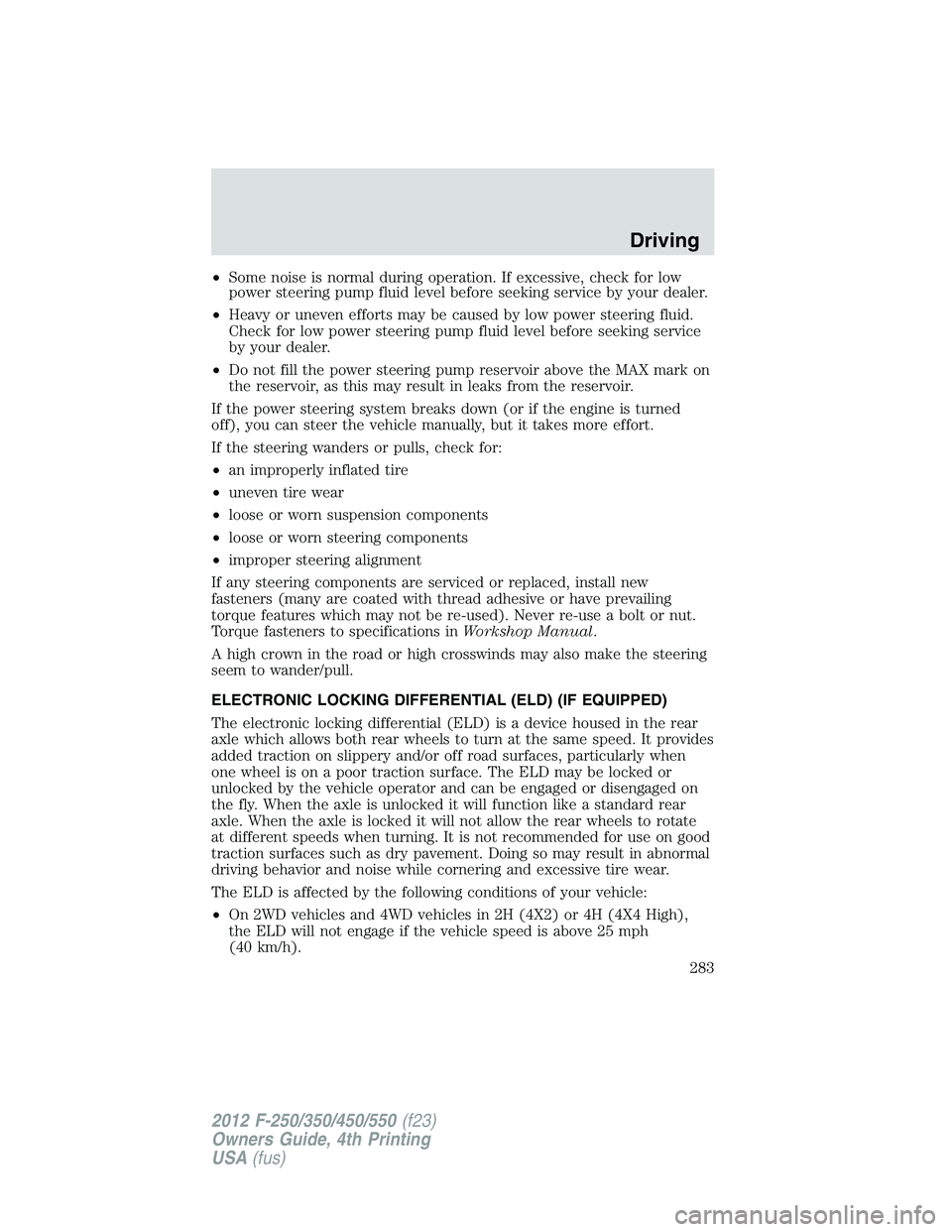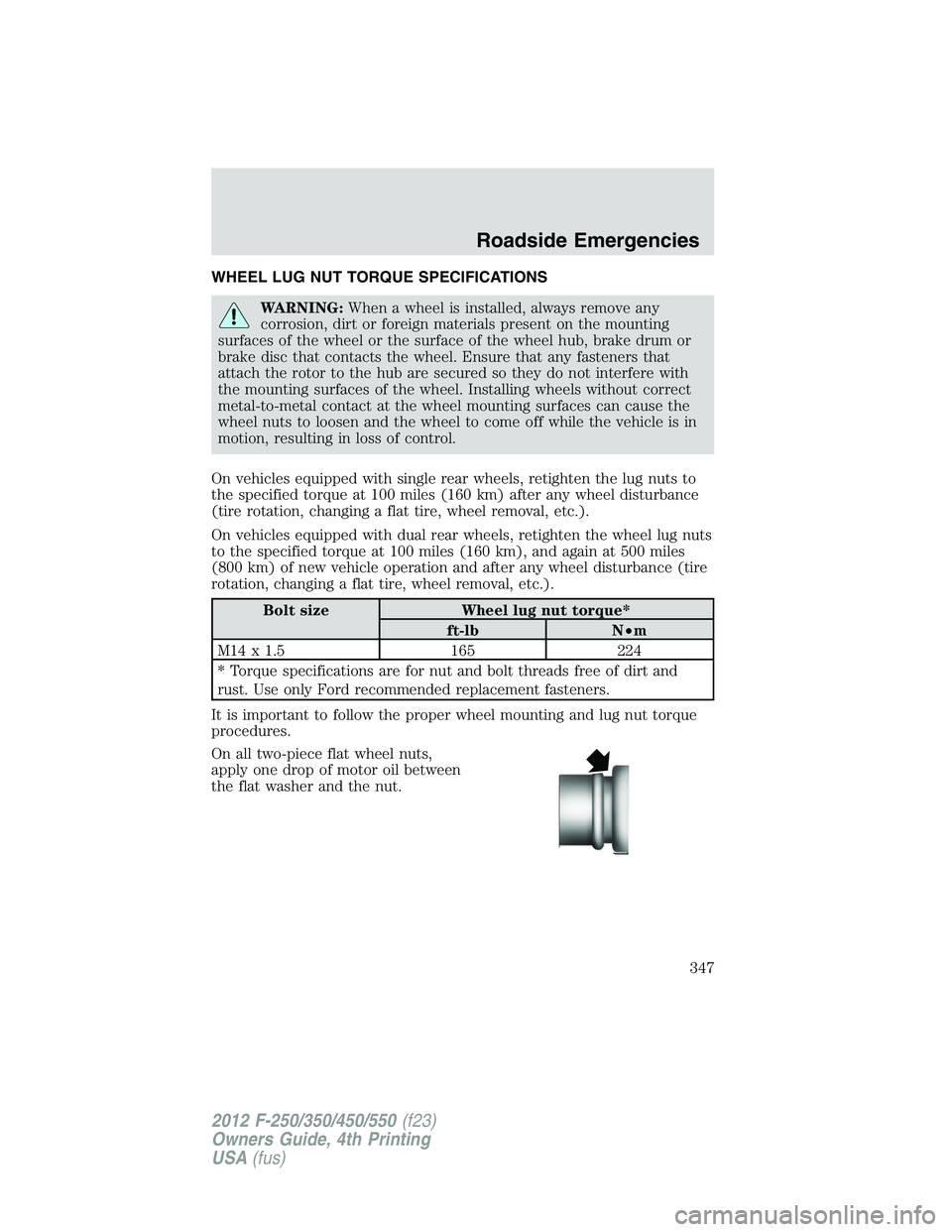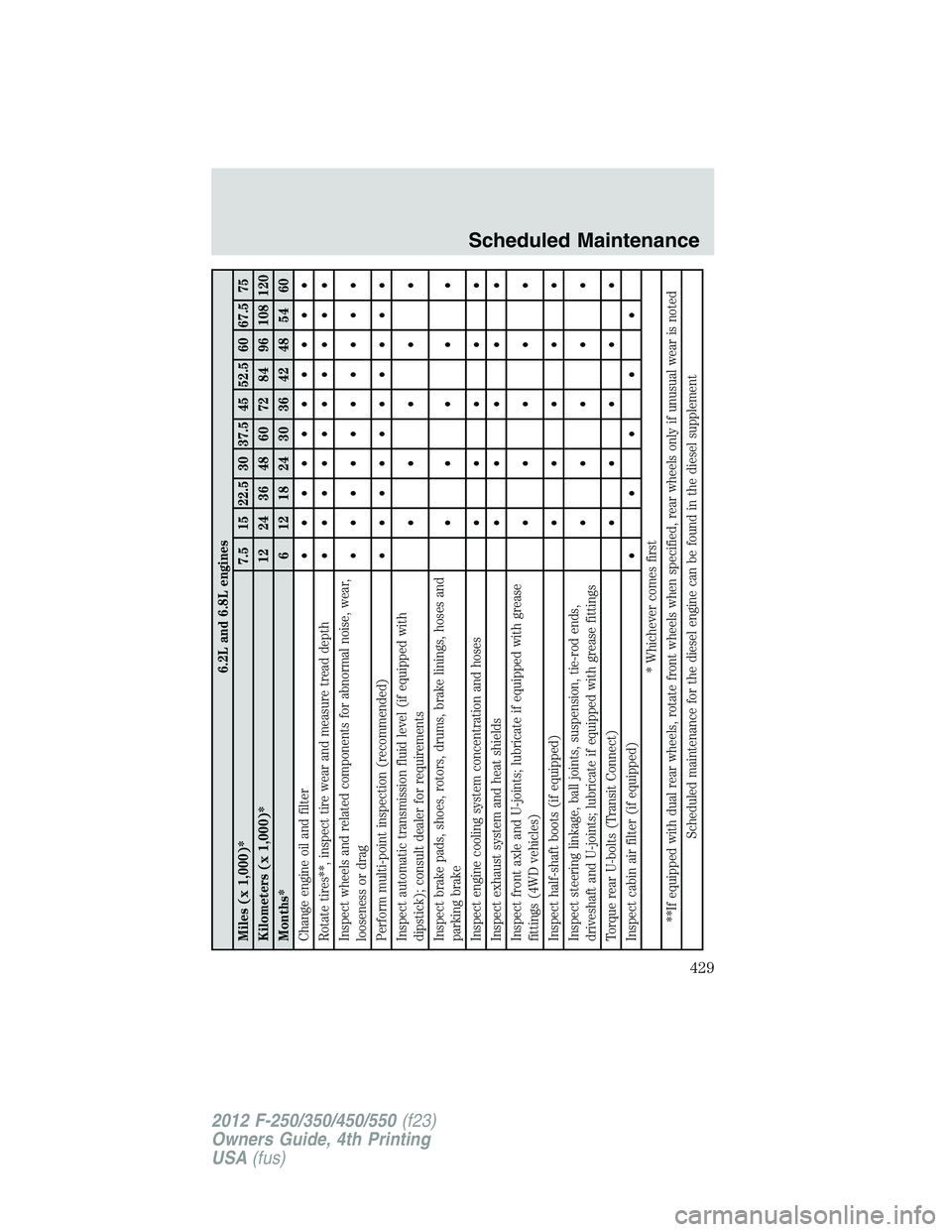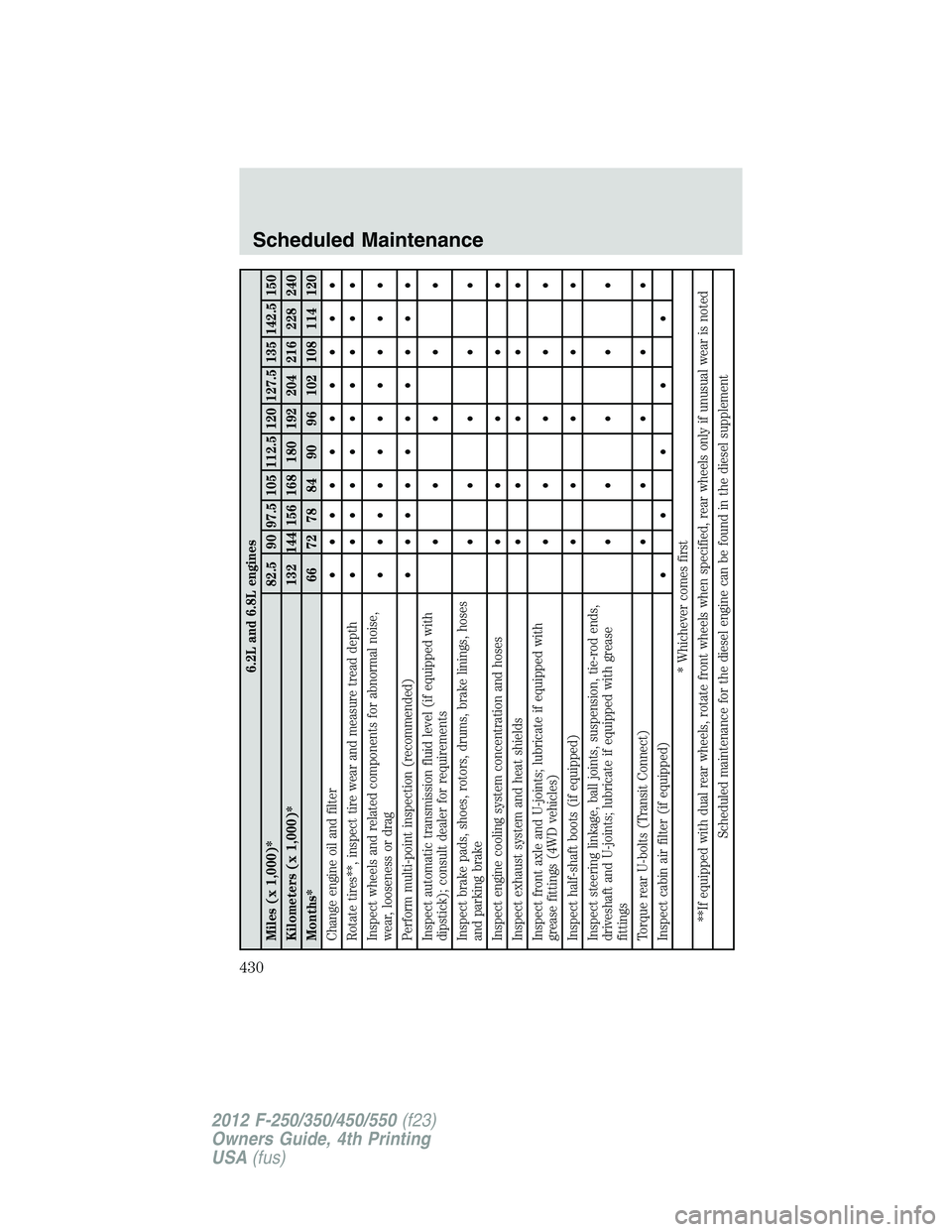Page 283 of 448

• Some noise is normal during operation. If excessive, check for low
power steering pump fluid level before seeking service by your dealer.
• Heavy or uneven efforts may be caused by low power steering fluid.
Check for low power steering pump fluid level before seeking service
by your dealer.
• Do not fill the power steering pump reservoir above the MAX mark on
the reservoir, as this may result in leaks from the reservoir.
If the power steering system breaks down (or if the engine is turned
off), you can steer the vehicle manually, but it takes more effort.
If the steering wanders or pulls, check for:
• an improperly inflated tire
• uneven tire wear
• loose or worn suspension components
• loose or worn steering components
• improper steering alignment
If any steering components are serviced or replaced, install new
fasteners (many are coated with thread adhesive or have prevailing
torque features which may not be re-used). Never re-use a bolt or nut.
Torque fasteners to specifications in Workshop Manual .
A high crown in the road or high crosswinds may also make the steering
seem to wander/pull.
ELECTRONIC LOCKING DIFFERENTIAL (ELD) (IF EQUIPPED)
The electronic locking differential (ELD) is a device housed in the rear
axle which allows both rear wheels to turn at the same speed. It provides
added traction on slippery and/or off road surfaces, particularly when
one wheel is on a poor traction surface. The ELD may be locked or
unlocked by the vehicle operator and can be engaged or disengaged on
the fly. When the axle is unlocked it will function like a standard rear
axle. When the axle is locked it will not allow the rear wheels to rotate
at different speeds when turning. It is not recommended for use on good
traction surfaces such as dry pavement. Doing so may result in abnormal
driving behavior and noise while cornering and excessive tire wear.
The ELD is affected by the following conditions of your vehicle:
• On 2WD vehicles and 4WD vehicles in 2H (4X2) or 4H (4X4 High),
the ELD will not engage if the vehicle speed is above 25 mph
(40 km/h). Driving
283
2012 F-250/350/450/550 (f23)
Owners Guide, 4th Printing
USA (fus)
Page 347 of 448

WHEEL LUG NUT TORQUE SPECIFICATIONS
WARNING: When a wheel is installed, always remove any
corrosion, dirt or foreign materials present on the mounting
surfaces of the wheel or the surface of the wheel hub, brake drum or
brake disc that contacts the wheel. Ensure that any fasteners that
attach the rotor to the hub are secured so they do not interfere with
the mounting surfaces of the wheel. Installing wheels without correct
metal-to-metal contact at the wheel mounting surfaces can cause the
wheel nuts to loosen and the wheel to come off while the vehicle is in
motion, resulting in loss of control.
On vehicles equipped with single rear wheels, retighten the lug nuts to
the specified torque at 100 miles (160 km) after any wheel disturbance
(tire rotation, changing a flat tire, wheel removal, etc.).
On vehicles equipped with dual rear wheels, retighten the wheel lug nuts
to the specified torque at 100 miles (160 km), and again at 500 miles
(800 km) of new vehicle operation and after any wheel disturbance (tire
rotation, changing a flat tire, wheel removal, etc.).
Bolt size Wheel lug nut torque*
ft-lb N • m
M14 x 1.5 165 224
* Torque specifications are for nut and bolt threads free of dirt and
rust. Use only Ford recommended replacement fasteners.
It is important to follow the proper wheel mounting and lug nut torque
procedures.
On all two-piece flat wheel nuts,
apply one drop of motor oil between
the flat washer and the nut. Roadside Emergencies
347
2012 F-250/350/450/550 (f23)
Owners Guide, 4th Printing
USA (fus)
Page 429 of 448

6.2L and 6.8L engines
Miles (x 1,000)* 7.5 15 22.5 30 37.5 45 52.5 60 67.5 75
Kilometers (x 1,000)* 12 24 36 48 60 72 84 96 108 120
Months* 6 12 18 24 30 36 42 48 54 60
Change engine oil and filter • •••••••••
Rotate tires**, inspect tire wear and measure tread depth • •••••••••
Inspect wheels and related components for abnormal noise, wear,
looseness or drag • •••••••••
Perform multi-point inspection (recommended) • •••••••••
Inspect automatic transmission fluid level (if equipped with
dipstick); consult dealer for requirements •••••
Inspect brake pads, shoes, rotors, drums, brake linings, hoses and
parking brake •••••
Inspect engine cooling system concentration and hoses •••••
Inspect exhaust system and heat shields •••••
Inspect front axle and U-joints; lubricate if equipped with grease
fittings (4WD vehicles) •••••
Inspect half-shaft boots (if equipped) •••••
Inspect steering linkage, ball joints, suspension, tie-rod ends,
driveshaft and U-joints; lubricate if equipped with grease fittings •••••
Torque rear U-bolts (Transit Connect) •••••
Inspect cabin air filter (if equipped) • ••••
* Whichever comes first
**If equipped with dual rear wheels, rotate front wheels when specified, rear wheels only if unusual wear is noted
Scheduled maintenance for the diesel engine can be found in the diesel supplementScheduled Maintenance
429
2012 F-250/350/450/550 (f23)
Owners Guide, 4th Printing
USA (fus)
Page 430 of 448

6.2L and 6.8L engines
Miles (x 1,000)* 82.5 90 97.5 105 112.5 120 127.5 135 142.5 150
Kilometers (x 1,000)* 132 144 156 168 180 192 204 216 228 240
Months* 66 72 78 84 90 96 102 108 114 120
Change engine oil and filter ••••••••••
Rotate tires**, inspect tire wear and measure tread depth ••••••••••
Inspect wheels and related components for abnormal noise,
wear, looseness or drag ••••••••••
Perform multi-point inspection (recommended) ••••••••••
Inspect automatic transmission fluid level (if equipped with
dipstick); consult dealer for requirements •••••
Inspect brake pads, shoes, rotors, drums, brake linings, hoses
and parking brake •••••
Inspect engine cooling system concentration and hoses •••••
Inspect exhaust system and heat shields •••••
Inspect front axle and U-joints; lubricate if equipped with
grease fittings (4WD vehicles) •••••
Inspect half-shaft boots (if equipped) •••••
Inspect steering linkage, ball joints, suspension, tie-rod ends,
driveshaft and U-joints; lubricate if equipped with grease
fittings •••••
Torque rear U-bolts (Transit Connect) •••••
Inspect cabin air filter (if equipped) •••••
* Whichever comes first
**If equipped with dual rear wheels, rotate front wheels when specified, rear wheels only if unusual wear is noted
Scheduled maintenance for the diesel engine can be found in the diesel supplementScheduled Maintenance
430
2012 F-250/350/450/550 (f23)
Owners Guide, 4th Printing
USA (fus)